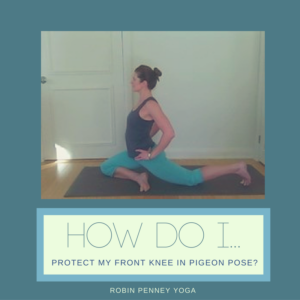
Got knee issues? I do…from running and sitting and living life. My right knee will always be “the sensitive one,” and I’ve had to baby my knees in my yoga practice a little bit. One pose where this comes up often is in Pigeon Pose or Eka Pada Rajakapotasana.
In my yoga classes, you will hear me talk about bringing a lot of activity into your legs in this pose (squeezing the inner thighs toward each other). I will encourage you to press the pinkie-toe side of your front foot down strongly, so that you smooth out any wrinkles on the inside of your ankle. Pressing the outside edge of your foot down strongly has the effect of toning the outer shin and making the lower leg into sort of “cast,” which can help protect the knee and move the stretch into the hip, where you really want it. If you sickle your foot and collapse through the ankle, you risk collapsing into the knee joint, and this hinge joint does not like that!!! There is a lot to this posture, and there are various modifications you can take that make this pose more accessible (read more below for that).
Here are some things that I DON’T teach or practice anymore and what I do instead:
- I don’t bring the shin parallel to the front edge of the mat. I used to practice Pigeon this way all the time, but it aggravated my knee over time, and I started wondering why I was putting myself through this! So now, I pull my front foot in pretty close to the opposite hip. Much better!! Note: I *sometimes* teach or practice with the option of taking the shin parallel to the front of the mat, but only in a practice where we might be leading up to an arm balance like Dragonfly or Flying Pigeon, and I want to see how everyone’s knees feel in this position. If the vast majority of the class can’t do this without pain in the knee, I would bag that plan and do something else, because I don’t want them moving onto an arm balance where this position of the knee is required.
- I don’t FLEX the foot. Instead, I prefer a “Barbie” foot (foot is pointed, and toes are flexed back). I can get a lot of good engagement in the leg like this, and it feels better to me than a true flex. You may be different…experiment!
- I don’t let the back leg totally collapse…unless I’m practicing the Yin version (Swan), in which case I do let things really relax 🙂 But in a yang practice, I like that back leg to be straight back, rolling the back inner thigh up toward the sky, hugging in toward the midline. Tucking the back toes really helps get this feeling at first, but then I typically like to stretch my toes straight back and reach long through that back leg.
There is a lot more to this pose…these are just some foundational elements in the legs that I’ve found to be very useful in my practice and with students. And of course, Reclined Pigeon is always a great option –> lying down, cross one ankle over the opposite knee…DO flex your foot and spread your toes and press out through the big toe mound on the foot that is crossed over to protect your knee….and then fold the knees in and interlace the hands behind the hamstring or shin on the bottom leg. Same outer hip stretch, just more accessible for some.
Remember that we all have different bodies, different days, and different moods. So practice with respect for your limits and work intelligently.
Namaste.

 Empowering women who are 40+ to install movement habits that are nourishing, strengthening, and approachable for a truly calm and connected life.
Empowering women who are 40+ to install movement habits that are nourishing, strengthening, and approachable for a truly calm and connected life.